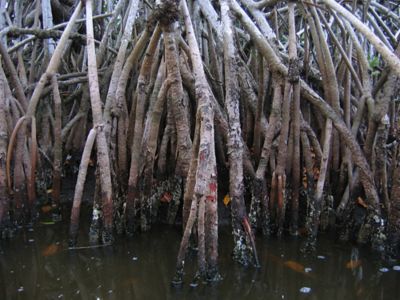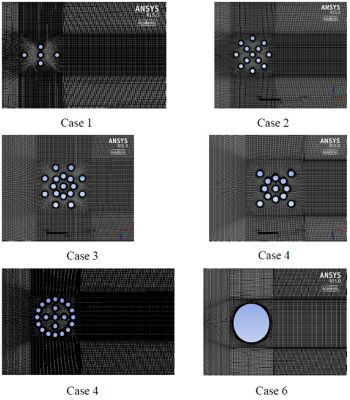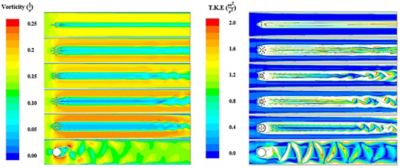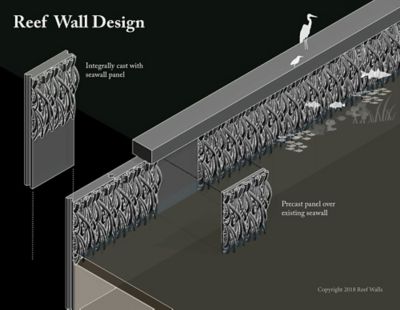-
United States -
United Kingdom -
India -
France -
Deutschland -
Italia -
日本 -
대한민국 -
中国 -
台灣
-
-
產品系列
查看所有產品Ansys致力於為當今的學生打下成功的基礎,通過向學生提供免費的模擬工程軟體。
-
ANSYS BLOG
March 06, 2019
Biomimicry of Mangroves Teaches How to Improve Coastal Barriers
Along tropical coastlines, red mangrove trees are hard at work. They accumulate fortifying layers of mud and decaying plant matter, effectively “rising” with the sea level. As a result, they guard against coastal erosion and protect shore communities from storm surge.
Their complex, exposed root system also nurtures juvenile fish and biodiversity. What’s more, mangroves reduce greenhouse gases by capturing and storing waste carbon dioxide.
The exposed root systems of mangroves help prevent erosion and nurture juvenile fish.
As a graduate student investigating "built ecologies,” I was first captivated by the architectural aspects of the mangrove that underly its industriousness. Mangroves are the only trees that can thrive in salt water and sustain such a richly diverse habitat.
Man-made coastal barriers, in contrast, are significantly less resilient. They are also environmentally unfriendly and unsightly, and costly to construct. I focused my research, therefore, on designing a mangrove-inspired coastal structure — one that would biomimic the mangrove in form and function.
Later, teaching at Florida Atlantic University (FAU), I found similarly inspired researchers — Oscar Curet and Amirkhosro Kazemi — in the department of ocean and mechanical engineering. We began exploring how the root system interacts with, and responds to, the fluid flows around it.
The Roots of the Solution to Coastal Erosion
To perform a hydrodynamic analysis, we had to create a representative model of the mangrove. This proved challenging given that there isn’t a “typical” mangrove.
Each tree is unique. The root structure varies greatly depending on location: inland waterway or coast, outside edge of a mangrove forest or along the shore.
We simplified the problem by modeling the roots as an array of circular cylinders (a “patch”). In five of the test cases, we kept the cylinder and patch diameters constant. In the sixth, we used a single cylinder with the same patch diameter, for comparison.
Six simulated patch configurations
Using computational fluid dynamics simulation, we were able to visualize the effect of different patch configurations on the turbulent (wake) flow.
How Mangroves Protect from Coastal Erosion
Looking at several flow structure parameters, including vorticity (rotation) and turbulent kinetic energy, we observed that the ease with which water can flow through the patch (the “porosity”) significantly impacted the downstream flow.
Ansys Fluent simulations of vorticity (left) and turbulent kinetic energy (right)
The less dense and more porous the patch, the weaker the vorticity and turbulent energy are directly behind the patch. Flow rotation determines if sediment will be carried (low vorticity) or deposited (high vorticity) downstream.
Turbulence is a key component in the initiation of sediment motion.
Both impact the buildup of sediment around the roots, which allows the trees to rise in concert with sea level.
Applying Biomimicry Along Florida’s Coast
Working with ecologists, biologists, engineers and contractors, I explored ways of installing cylindrical structures along the Florida coast.
Modifying a seawall with mangrove-like panels
Because municipal, state and federal laws prohibit property extension in many places, we could not install open-water, freestanding structures. However, regulations do permit seawall modifications: We could attach cylinders to existing seawalls.
After several iterations, our designs evolved into concrete panels with root-like projections. These semi-flexible “roots” have built-in gaps that facilitate water flow and create spaces for habitats to flourish.
To attract nearby oysters, we added crushed oyster shells to the concrete mix.
Results Show that the Biomimicry of Mangroves May Save Florida’s Coast
Currently, we are camera-monitoring three 20-foot modified seawalls. On a bimonthly basis, we document the population of each species in residence.
After only 18 months, the results show significant colonization on and around the panels.
We are also collaborating with the Florida Department of Environmental Protection to create and study 300 feet of modified seawall deployed across three test sites.
Comparison of oyster colonization on mangroves and modified seawalls
We will compare these installations with a bare seawall and a planted mangrove shoreline adjacent to the panels. The results will then be shared with coastal homeowners for future construction consideration.
And this is just the beginning. We hope to test and build root configurations that more closely mirror both the deep-water edge and swampy inland conditions found in mangrove forests. Using hydrodynamic simulation, wave-tank studies and physical prototyping, we aim to create surge-resistant coastal structures that decelerate the surrounding water flows. This will dampen the soil- or sand-eroding turbulent energy and recreate the habitats lost when the sea walls replaced nature.
Learn more about Ansys Fluent computational fluid dynamics software. Or get a free trial today!
Oscar Curet is an assistant professor at Florida Atlantic University. His research has been funded by the National Science Foundation (NSF) and the Office of Naval Research (ONR).
Amirkhosro Kazemi is a postdoctoral research fellow at Florida Atlantic University. His work on the hydrodynamics of mangrove-root models has been on Science, Phys.org, EurekAlert and ScienceDaily.















